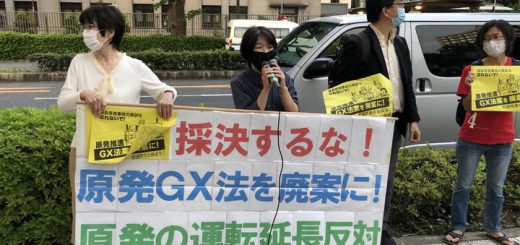Problems with extending the time between periodic inspections Nuke Info Tokyo No. 140
Higashidori-1: application for extended operation cycle
On October 15 Tohoku Electric Power Company announced that it planned to increase the length of continuous operation of its Higashidori-1 reactor (BWR, 1110 MW) from the current 13-month cycle to a 16-month cycle.
Until now, Japanese nuclear power plants had to be shut down for periodic inspections after 13 months of operation, even if there were no incidents or damage. During periodic inspections, nuclear power plants are examined by the Nuclear Industrial and Safety Agency (NISA). In addition, the electric power company inspects equipment that is not subject to NISA inspection and replaces fuel assemblies. The plant may only resume commercial operations after it has cleared these inspections.
The inspection system ordinance was amended on August 29, 2008 (see NIT 126). The new system, which came into effect on January 1, 2009, allows for the possibility that reactors may be operated continuously for up to 24 months. However, for the first five years after the new system came into effect the maximum continuous operating time is 18 months. Tohoku Electric wants to take advantage of these new rules in the operation of its Higashidori-1 plant. (See diagram below.)
Also, it was reported on October 30 that Shikoku Electric Power Company plans to extend the period of continuous operation for its Ikata Nuclear Power Plant.
On November 10, Tohoku Electric submitted a revision under the Electricity Business Act to its “Operational Safety Plan, Electric Industry Electric Facilities for Business Use (Facilities for Nuclear Power Generation)”. At the same time, it applied for a variation under the Reactor Regulatory Act to the “Higashidori Nuclear Power Plant Reactor Facilities Operational Safety Plan”, which stipulates the conditions it must fulfill in operating the plant.
Objective of new inspection system is improved capacity factor
Outlined below are some of the problems with the Higashidori-1 plan, based on documentation being considered by government subcommittees reviewing Tohoku Electric’s application.
I accept the notion of requiring electric power companies to produce quality assurance plans for checks and safety assurance and permitting extended operation cycles as a reward for accident- and incident-free operation. However, Japan’s prime objective for introducing the system introduced in the United States in the 1990s is to raise the capacity factor. Even Tohoku Electric’s press release and explanatory documentation state, albeit in muted tones, that an objective of lengthening the time of continuous operation is to raise the capacity factor.
One senses danger when the priority in introducing this system is not safety, but continuous operation.
Longer time between equipment checks
By lengthening the period of continuous operation, the time between equipment checks is also lengthened for those items of equipment that can only be checked when the plant is not operating. This increases the risk that damage and degradation will go unnoticed. Under pressure to raise the capacity factor, there is a danger that when the chance to check the equipment finally comes around adverse results will be ignored.
It is argued that new technology for inspecting the state of a nuclear power plant’s equipment while it is still operating will be introduced to supplement the periodic inspections. This new technology includes vibration diagnostics to identify abnormalities in the vibration of rotating equipment such as turbines and motors, lubricating oil diagnostics to detect deterioration of lubricating oil and wear and tear on shafts, and infrared thermography diagnostics to detect localized overheating. However, judging from the status of Tohoku Electric’s trials, this technology is still in the testing stage and cannot be used with confidence.
The Higashidori-1 technical assessment selected 37 representative items of equipment, based on similarity of material quality and use conditions. These were chosen from about 1,000 important items of equipment that cannot be repaired or replaced while the plant is operating. For those 37 items, the assessment first confirmed whether appropriate responses to past accident examples had been taken. Then, based on checks of equipment deterioration data gathered during the latest periodic inspection, and research results published by other organizations, the assessment confirmed that the plant could be operated continuously for 26 months without repairs or replacements to this equipment. In light of this result, Tohoku Electric applied to operate the plant continuously for 16 months.
I do not believe that the selection of 37 items of equipment based on similarity of material quality and use conditions has any scientific basis. Reports appear frequently about deterioration of items of equipment such as recirculation pump seals. A strict assessment would probably conclude that 16 months continuous operation is difficult for such items.
Problems of fuel management arising from extended operating cycles
Extended operating cycles require correspondingly more fuel (more fissile material). The level of uranium enrichment is stipulated in the application for a reactor establishment license. So, unless the license is amended, more assemblies must be replaced during refueling.
However, since it is not possible to burn this at full power immediately, the core has to be managed more carefully than in the past, for example by including substances which absorb neutrons, such as gadolinia, in the fuel assemblies, or inserting some of the control rods into the reactor during operation.
For this reason, we would expect to see more fine damage to fuel assemblies and cracking of control rods. Also, a report by the working group assessing the safety implications of an extended operating cycle for Higashidori-1, assessed that there would be a slight reduction in the stability of the core. Although the assessed reduction in stability is small, this is not a problem that should be treated lightly.
Chihiro Kamisawa (CNIC)


